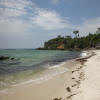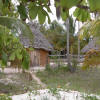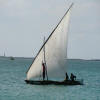
Dar es Salaam
Dar es Salaam (Arabic: دار السلام
[translation: "Abode of Peace"] Dār as-Salām), formerly Mzizima,
is the largest city in Tanzania. With a population estimated around 2,500,000,
it is also the country's richest city and a regionally important economic
centre. Though Dar es Salaam lost its official status as capital city to Dodoma
in 1996, it remains the centre of the permanent central government bureaucracy
and continues to serve as the capital for the surrounding Dar es Salaam Region.
|
|
|
|

|
|
|
|
|
|
General view at Dar es Salaam city |
|
|
|
|
|
|

|
|
|
|
|
|
Harbour view. Lutheran church. |
|
|
|
|
|
|

|
|
|
|
|
|
Lutheran church in Dar es Salaam is the oldest church in the city. It was built by Germans during their colonial time. |
|
|
|
|
|
|
|

|
|
|
|
|
|
Coco Beach. Popular place for week end picnic for city-dwellers. |
|
|
|
|
|
|

|
|
|
|
|
|
Oysterbay. View from Dar es Salaam Yacht Club. |
|
|
|
|
|
|

|
|
|
|
|
|
The climate in Dar is hot and humid. Fresh coconut juice is the best resort to quench one's thirst. |
|
|
|
|
|
|
|

|
|
|
|
|
|
Improvised fruit market in downtown. |
|
|
|
|
|
|

|
|
|
|
|
|
Barrow-boy selling oranges. Downtown Dar es Salaam. |
|
|
|
|
|
|
|
In 1859, Albert Roscher of Hamburg became the first European to land in
Mzizima ("healthy town"). In 1866 Sultan Seyyid Majid of Zanzibar gave it its
present name. A popular but erroneous translation is "haven of peace" resulting
from a mix-up of the Arabic words "dar" (house) and "bandar" (harbour). Dar es
Salaam fell into decline after Majid's death in 1870, but was revived in 1887,
when the German East Africa Company established a station there. The town's
growth was facilitated by its role as the administrative and commercial centre
of German East Africa and industrial expansion resulting from the construction
of the Central Railway Line in the early 1900s.
Tanzanians are very creative people. They are
talented from birth for music, dancing and arts.
|
|
|
|

|
|
|
|
|
|
African craft market at Slipway. This is more tourist-oriented place. Prices are higher and the quality leaves much to be desired. |
|
|
|
|
|
|

|
|
|
|
|
|
In these small old craft shops in downtown Dar sometimes you can find a real masterpiece. Tanzania is famous for its ebony carving. |
|
|
|
|
|
|

|
|
|
|
|
|
Mwenga craft market.This is a place where you can not only buy a good ebony stuff but ... |
|
|
|
|
|
|
|

|
|
|
|
|
|
... also see how it is made in front of your eyes. Unbelievable how they make it using their primitive tools.
Wood-carver at Mwenga market. |
|
|
|
|
|
|

|
|
|
|
|
|
Ebony crafts are sold everywhere and of course at the most tourist-attractive areas of Dar es Salaam.
Sunrise Beach resort. |
|
|
|
|
|
|

|
|
|
|
|
|
Wonder Welders. This is a producers' co-operative involving talanted disabled craftspeople. Amazing what can be made of a scrap peaces of metal. |
|
|
|
|
|
|
|

|
|
|
|
|
|
After successful shopping at the craft market :) |
|
|
|
|
|
|

|
|
|
|
|
|
Wedding party.
Not sure, but I think women came to prepare the bride for the ceremony. |
|
|
|
|
|
|

|
|
|
|
|
|
Drums and jingles. That's all what is needed to spark an inflammatory traditional dancing.
Dancers at Sunrise Beach resort. |
|
|
|
|
|
|
|

|
|
|
|
|
|
Big Masai ... little Masai ;) |
|
|
|
|
|
|

|
|
|
|
|
|
You won't believe that this still water is the Indian Ocean.
Oysterbay. |
|
|
|
|
|
|
|
|
Sunsets are very spectacular in Dar. Tropical
orbit of the Sun in combination with warm evening atmosphere give inexpressible
colors of sunset over the Indian Ocean.
Warm waters of the Indian Ocean, fresh seafood and
lovely warm climate through the year make Tanzania very attractive for tourists
from all over the world.
|
|
|
|

|
|
|
|
|
|
Amani Beach.
A beautiful laguna resourt about 80km away from Dar es Salaam. |
|
|
|
|
|
|

|
|
|
|
|
|
Rates for such bungalow type beach hotels may compare to 4-star hotels in Europe. |
|
|
|
|
|
|
|
|

|
|
|
|
|
|
These canoe were used centuries ago and retained their original shape and Latin sail. |
|
|
|
|
|
|
|
|
|
The town of
Bagamoyo, was founded at the end of the 18th century. It was
the original capital of German East Africa and was one of the
most important trading ports along the East African coast. In
the late 18th century Muslim families settled in Bagamoyo. They
made their living by enforcing taxes on the native population
and by trading in salt, gathered from the coast north of
Bagamoyo. In the first half of the 19th century, Bagamoyo became
a trading port for ivory and the slave trade, with traders
coming from the African interior. This explains the meaning of
the word Bagamoyo ("Bwaga-Moyo") which means "Lay down your
Heart" in Kiswahili. The slave trade in East Africa was
officially prohibited in the year 1873, but continued
surreptitiously well to the end of the 19th century.
|
|
|
|

|
|
|
|
|
|
German Mission building. Bagamoyo, 18th century.. |
|
|
|
|
|
|

|
|
|
|
|
|
This place has a dark history related to the slave-trading period. Slaves were transported by boats from here to Zanzibar, where they were eventiually sold. |
|
|
|
|
|
|

|
|
|
|
|
|
Craft traders at the beach of Bagamoyo. |
|
|
|
|
|
|
|

|
|
|
|
|
|
Old fishing canoe and the Indian Ocean. |
|
|
|
|
|
|
|
|
Back to Top.

Zanzibar
The Zanzibar archipelago was once the separate
state of Zanzibar, which united with Tanganyika to form Tanzania (derived from
the two names), and still enjoys a high degree of autonomy within the union. The
word "Zanzibar" probably derives from the Persian زنگبار, Zangi-bar
("coast of the blacks") and it is also known as Zanji-bar in Arabic. Traders
from Arabia, mostly from Yemen, the Persian Gulf region of modern-day Iran
(especially Shiraz), and west India probably visited Zanzibar as early as the
1st century and began to settle in small numbers on Zanzibar in the late 11th or
12th century. In 1698, Zanzibar became part of the overseas holdings of Oman,
falling under the control of the Sultan of Oman. Slave traffic under the Sultan
thrived along with an expanding economy in clove spice.
|
|
|
|

|
|
|
|
|
|
Streets of Zanzibar historic Stone Town |
|
|
|
|
|
|
|

|
|
|
|
|
|
Citadel of Zanzibar fort. |
|
|
|
|
|
|
|

|
|
|
|
|
|
Reminder of the dark history of slave trade in Zanzibar. Hundreds of slaves were kept in these narrow chambers .. |
|
|
|
|
|
|

|
|
|
|
|
|
Very often whole families were separated. Zanzibar was one of the biggest slave markets in East Africa. |
|
|
|
|
|
|

|
|
|
|
|
|
Unique fragrance of Arabic perfume! ...
Perfume shop in Zanzibar Stone Town. |
|
|
|
|
|
|
|

|
|
|
|
|
|
"You ask credit, I no give. You get mad.
I give credit, you no pay. I get mad.
Better you get mad"
This poster was spotted at one of Zanzibari shops. |
|
|
|
|
|
|

|
|
|
|
|
|
View at the Palace of Miracles. |
|
|
|
|
|
|

|
|
|
|
|
|
Geometrical harmony.
Streets of Stnoe Town, Zanzibar. |
|
|
|
|
|
|
|
|

|
|
|
|
|
|
Fisherman maintains his canoe. |
|
|
|
|
|
|

|
|
|
|
|
|
Fabulous sunset at the East coast of Zanzibar. |
|
|
|
|
|
|
|
Back to Top.

Central Tanzania, lakes Victoria and Tanganyika
|
|
|
|
|

|
|
|
|
|
|
This rainbow was spotted in the central part of Tanzania. |
|
|
|
|
|
|

|
|
|
|
|
|
Roads become impassable during the rain season. |
|
|
|
|
|
|
|

|
|
|
|
|
|
Sunset over the lake Tanganyika. |
|
|
|
|
|
|
|
|
|
As of January 2007 Tanzania was
hosting almost half a million refugees from Democratic Republic of Congo and
Burundi. These refugees fled in Tanzania during different ethnic conflicts in
1980's-1990's. The following pictures were taken in Lugufu refugee camp in
Western Tanzania.
Tanzania is famous for its
wildlife resorts and national parks. Serengeti, Ngorongoro, Ruaha and many other
smaller national parks are widely shown on TV almost every day. These pictures
were taken at Mikumi national park in central part of Tanzania, Morogoro region.
Back to Top.








